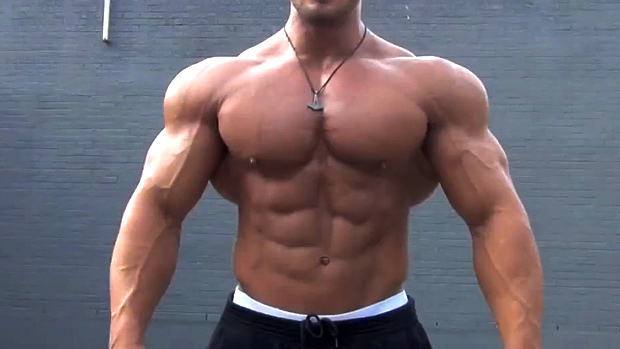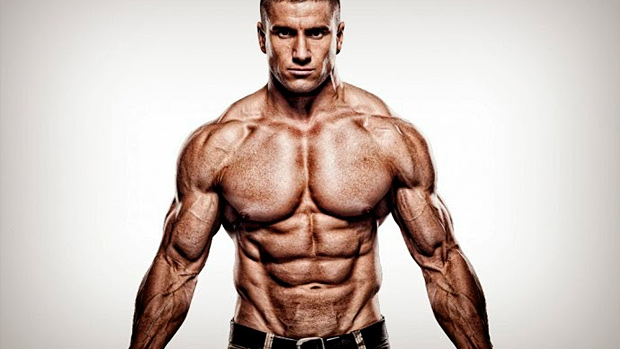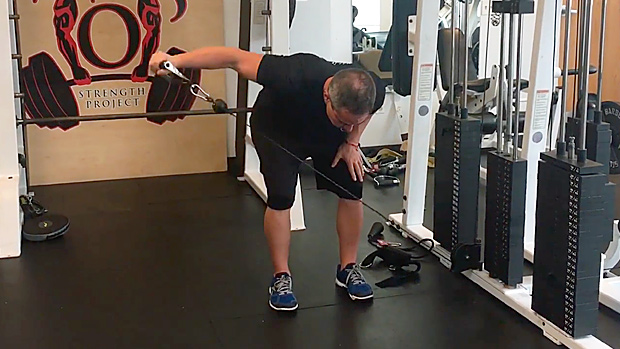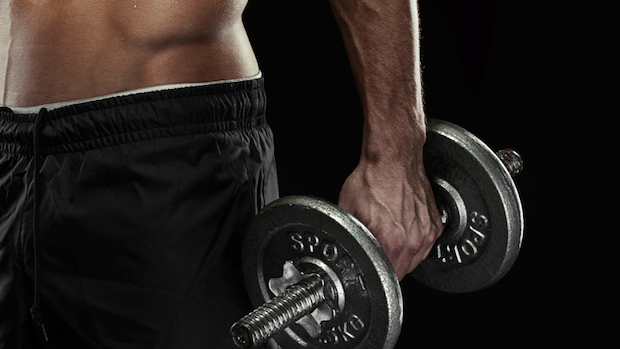For many of our contributors, Testosterone magazine is kind of like the Hotel California of bodybuilding, meaning that you can check out anytime, but you can never leave (unless we kick your miserable ass out).
Take a look at the Authors list under the magazine drop down. Some of those guys have been contributing to Testosterone for more than 10 years, alternating between periods of rapid-fire article productivity with dry-spells reminiscent of 1930's-Oklahoma.
Chad Waterbury introduced himself to Testosterone readers way back in 2001 with a cool grip training article and followed it up with game-changing programs like Anti-Bodybuilding Hypertrophy and Total Body Training that made him a favorite among readers. The groundbreaking article Everything is About to Change was like a bomb going off in strength training circles, and solidified Chad's place as a coach who wasn't afraid to question conventional strength training dogma to achieve better results, faster.
Recently, Chad's article contributions have dropped off as his career has taken him in two seemingly opposing directions: whipping Hollywood starlets and elite level Mixed Martial Arts fighters into their all-time best condition.
The O.C. meets the Octagon? Can you say, "career dichotomy"? We don't quite get it either. Although to have the kind of client list he has, Chad must know something about burning fat and building muscle.
We sat down with Chad to see if there's anything Testosterone readers can learn...
T Nation: Well Chad, it's been a while. What the heck have you been up to?
First off, I want to say that it's great to be here. I haven't written much recently because I've been really busy training, as well as I've been designing a new system to boost athleticism while burning fat.
T Nation: Isn't that like trying to ride two horses with one ass?
Ha, no not necessarily. Boosting strength and speed, and getting lean, actually go hand-in-hand. That's because the key to getting super lean is to train with parameters that are more in sync with performance development, especially explosive strength endurance.
T Nation: Interesting. So is this is the point where you try to convince us that everything we thought we knew about fat loss is wrong?
Hardly. But I will say that the average Joe is making three typical mistakes when training for fat loss.
The first mistake people make is that they don't lift weights that are heavy enough to preserve their muscle mass. In the past, when bodybuilders needed to shed fat for a contest, it was typical for them to switch over to workouts with lighter weights and higher reps.
It's that old "train for the burn" dogma. If your muscles are burning, that must mean your body is burning fat, right? It was also typical for them to lose a significant amount of muscle in the process. That's why they'd bulk up to a massive body weight in the offseason.
T Nation: So your average guy trying to get to single-digit bodyfat should train with doubles and triples?
No, a 6-12 repetition maximum is heavy enough to get the job done. One of the most effective ways to keep all your muscle is to stimulate all your muscle fibers while training. Just accelerate each lift and you've tapped into the biggest, strongest muscle fibers that are the first to go with light, high rep training. It's like that old saying goes: if you don't use it, you lose it.
T Nation: That's a classic saying I actually agree with. And mistake number two?
The second mistake is with rest periods. People generally rest for too long between sets and this drastically reduces the cardiovascular demand of a workout. The fear is that they'll lose strength if they limit recovery. However, recent research by Alcaraz, et al., that strength gains between 35-second and 3-minute rest periods are similar when the load and exercises are right.
T Nation: Really? 35 seconds is definitely not a long rest interval, especially compared to 3 minutes.
Exactly. That is what's so exciting about this research. It basically says that by limiting rest intervals between sets, you can greatly enhance the cardiovascular demand of a weight-training workout and burn more calories without the fear of compromising strength gains to any significant degree.
This is great news for athletes and non-athletes because they can train for less time and still boost their strength and cardiovascular systems simultaneously.
T Nation: I know a number of lifters who claimed to gain size and strength when they switched to shorter rest intervals. Maybe they weren't crazy after all. And mistake number three?
The final mistake pertains to bodypart split training. Split training might be good for advanced bodybuilders but it falls short when the goal is to strip fat off your body.
T Nation: But 99.9% of competitive bodybuilders follow some type of spilt routine....
...and bodybuilders are the most diligent dieters in the world, so their fat loss comes from an insanely restrictive diet. It's not a result of their training split. If you're someone who doesn't like to take dieting to such an extreme, you must boost the metabolic cost of a workout as high as possible to stimulate fat loss.
Metabolic cost is a measure exercise scientists use to determine how much your physiology is disrupted through exercise. This might sound grim, but it's not.
You see, it takes a lot of energy (calories) to restore your physiology back to normal after it's been challenged. So your body uses more calories after a full-body circuit than it does after a shoulder workout. The most effective ways I've found to boost the metabolic cost of a training session is with a hybrid style of training that consists of strength training circuits, dynamic cardio strength exercises, and short rest periods.
Then, you must adhere to a progression plan to ensure that your body is constantly challenged week after week.
T Nation: Won't a more "traditional" approach (heavy weights + steady state cardio) still do the trick?
It'll do the trick if you're not in any kind of hurry to get lean, if you can afford to lose some muscle mass, and if explosive athleticism isn't a priority. Let me also remind you that whether the athlete is natural or not has a huge impact on the effectiveness of the "traditional" steady state cardio bodybuilding approach. Not pointing fingers or anything, just stating a fact.
Heavy weight training is very effective for building muscle mass, and that's why bodybuilders do it. However, when they pair it up with low-intensity cardio they invariably eat up a lot of the muscle they've built.
When your muscles have to continuously contract for an hour that energy has to come from somewhere. It's very easy for your metabolism to break down muscle tissue for energy, and it usually does. Seriously, have you ever seen a marathon runner with big, muscular legs?
Tremblay's research was groundbreaking because he taught us that we should think less about the metabolic changes that occur during a workout and focus more on what's happening after you stop training. He compared high intensity and low intensity protocols. The high intensity group burned fewer calories during the workout, but their reduction in skinfold measurements was nine times greater by the end of the study.
So yeah, regular cardio will burn fat but not nearly as fast as high intensity cardio. But it's not as simple as merely alternating between sprinting and jogging. There are more effective ways to get the job done.
T Nation: Such as?
Tabata's research shows that just a few minutes of high intensity cardio will boost your aerobic and anaerobic conditioning. This is important for fighters who are constantly toeing the line between fatigue and performance because of all the striking, grappling, and other forms of fighting they must constantly practice.
Not to mention their strength and conditioning sessions. Bottom line: with high intensity cardio you kill two birds with one stone.
T Nation: But a big part of all this is diet. I mean, I think we can agree that an individual can lose fat on a number of different approaches if they're eating appropriately for fat loss?
Sure, but that's a really big 'if'. To be honest, the vast majority of folks trying to lose fat that I consult with are completely dropping the ball in the kitchen as well as the gym. They typically make the same three nutrition mistakes when trying to eat for fat loss:
First, people cut too many calories, too fast. This is a big mistake that forces your body to release fat-storing hormones while your anabolic hormones plummet.
Getting ripped requires you to stimulate your metabolism to burn fat without breaking down muscle tissue. That's a no-brainer. But in reality, what most people instinctively do is the exact opposite of what the metabolism needs, so it shuts down. And when it does look for energy, it eats up your muscle.
Second, people just eat less of whatever they're currently eating. You see, the real problem with low calorie diets is not a lack of calories; it's a lack of nutrients. Vitamins, minerals, amino acids, omega-3s and other phytonutrients are what keep your metabolism running strong. Most people don't get enough of these nutrients, even when they're eating to bulk. So when they drastically cut calories, they end up giving their metabolism even fewer of the essential nutrients it needs. The Velocity Diet works so well because it feeds your body plenty of nutrients in absence of calories.
T Nation: But you still need an energy deficit to lose weight. How do you suggest people mitigate the drop in nutrients associated with reduced food intake?
The solution is as simple as taking out low-quality carbs such as potatoes, rice, and pasta and replacing it with berries and vegetables from a farmer's market, because those foods are the most potent, nutritionally speaking.
For protein, you should eat organic beef, chicken, and wild fish because they contain the most nutrients while being void of many of the toxic byproducts that upregulate fat-storing hormones.
The third mistake I see relates to the peri-workout period. To lose fat at an optimal rate without sacrificing your hard-earned muscle size, you must take full advantage of workout nutrition. Biotest is definitely the leader in this race. Feeding your muscles branch chain amino acids, and beta-alanine before a workout offsets fatigue and catabolism so you can train at a higher intensity for longer. After a workout, you must take in plenty of amino acids along with some high-quality carbs.
T Nation: People seem to associate pre and post-workout nutrition with the mega-calorie weight gainers of the 90's and think that they need to drop all forms of workout nutrition during fat loss phases.
I agree, and it's a huge mistake. In fact, I would submit that peri-workout nutrition is even more important during fat loss phases, considering the propensity to lose muscle is so much higher.

T Nation: Let's switch gears. I watched Ralek Gracie's impressive win over Sakuraba and noticed your name and logo on his banner. Tell us about that.
Yeah, Ralek hired me to train him for that fight because he wanted to boost his strength, power, and endurance. In other words, he needed to get in incredible shape. I created a system called Body of F.I.R.E. that he uses for his strength and conditioning program.
Whether you want to build the explosive strength endurance of a professional fighter, or just burn off body fat quickly, I use a system composed of Full-Body, Intense, Resistance Exercise - hence the acronym.
T Nation: So it's a system designed to shape up elite MMA fighters?
No, it's a system designed for anyone who needs to get in shape fast. I live in Los Angeles, and I work with a lot of fighters who need to build combat strength endurance. I also work with some celebrities who need to burn fat, like, yesterday.
Those might seem like separate markets with different goals, but they're not. Since the quickest way to burn fat is to train more like an athlete, the two actually coalesce in many ways. Fighters can't afford to lose any size or strength when they prepare for a fight. And non-athletes can't afford to do so either, since losing muscle mass slows your metabolism.
And when you lose strength you can't lift as explosively which limits the amount of fat and calories you'll burn while training.
Just look at recent research by McBride, et al. His team showed that getting stronger will boost your 10 and 40-yard sprint times.
The sequence goes like this: when you gain strength you can lift faster and this, in turn, increases the metabolic cost of an exercise which leads to greater fat burning.
My client, Jon, is an excellent example of how dramatically you can transform your body when you follow this system. He lost over 40 pounds of fat without sacrificing any muscle or strength. I'll concede that he shaved, tanned, and lost his shoes, but the rest speaks for itself. I think he has a body that many Testosterone readers will appreciate.


T Nation: Makes sense. But to be honest, what you're talking about isn't really breaking news to anyone who reads Testosterone consistently. What's unique about the Body of F.I.R.E. system?
I like the word you used there, system, cause that's exactly what Body of F.I.R.E is. It's not just a workout you follow four days a week; it's a system of metabolic workouts and targeted nutrition that builds performance without sacrificing strength or muscle in the process.
I think what Testosterone readers would be most interested in are my cardio strength parameters. These consist of exercise pairings or circuits that don't require as much load as maximal strength training, but the load is much higher than a typical cardio workout so it generates a higher metabolic cost.
T Nation: Cardio strength? Is this in place of traditional cardiovascular exercise?
Yes. Steady state cardio protocols like riding a stationary bike for 45-minutes are painfully obsolete. Let's face it, that kind of hamster work is boring, time consuming, and it makes athletes slower, less explosive, and they lose muscle. It's also completely unnecessary if you hit these cardio strength drills as hard as possible.
T Nation: Got an example for Testosterone readers to try?
Sure. If you're looking to get leaner, here's a sample cardio strength method you can do after your current workout in place of that endless treadmill walk to nowhere most people do after strength training.
One note: you must be able to perform at least 15 body weight pull-ups, and you need a kettlebell that you can swing for around 15 challenging reps.
Start with 10 pull-ups, then drop to the floor and do 10 clap push-ups, then do 10 kettlebell swings - all in a row without resting.
As soon as 10 reps of each are finished, do nine reps of each. Then do eight reps, seven reps, etc. until you work your way down to one rep of each exercise. Perform each rep as fast as possible and transition quickly between exercises. There's no room for rest.
Sets: 10
Reps: 10-1
Rest: zilch
1A) Pull-up
No rest
1B) Clap push-up
No rest
1C) Swing
No rest and repeat 1A-1C nine more times (drop a rep with each set)
Another example, if you're really short on time, is to pair up the clap push-ups with a kettlebell swing for descending reps.

To get stronger abs, perform the push-ups from suspended rings, since the University of Waterloo's research shows it drastically increases core activation. If you have a little more time, you can start with a higher number of reps, say, 15 and work your way down to one.
T Nation: That sounds rough!
It's a killer. In the last few weeks leading up to a fight I'll have my fighters start at 20 reps of a circuit of pull-ups and push-ups from rings with kettlebell swings, and they'll perform the entire circuit, all the way down to one rep of each exercise, without resting. That's how you build strength endurance!
T Nation: Let's talk iron. If a guy is trying to lean out, you suggest sets of 6-12 reps but with a short rest interval?
Not exactly. The strength-building portion of the workouts is composed of circuits, not straight sets, with short rest periods according to Alcaraz's findings mentioned earlier. But one of the ways Body of F.I.R.E is such a metabolic ass-kicker is the rep-target system, or lack thereof.
My "Huge in a Hurry" system was based around stopping your sets once your speed dramatically slows down to keep fatigue in check. Each exercise had a target number of reps, say, 25.
It's a little different, however, with my Body of F.I.R.E. system. All sets are performed for a maximum number of reps without regard for speed. Sure, I want you to accelerate every rep, but I don't care if the speed slows down. And there's not a target number of total reps for any exercise. You'll just rep out as many as you can with each set.
You'll start with a specific load, say, a load you can lift 12 times for the first set, and then you'll perform as many reps as you can for all subsequent sets. In other words, you'll push yourself a little farther in the sets.
T Nation: That's a definite departure for you. Why the change?
First and foremost, because fighters need more endurance than bodybuilders. Second, training this way increases the metabolic cost of a workout so you'll burn more fat. Since the Body of F.I.R.E. system has different goals than my Huge in a Hurry program, it requires a different approach. From there, the progression plan ensures that everything falls into place.
Importantly, the Body of F.I.R.E. program can be modified to suit anyone at any level of fitness. It's as simple as switching a few exercises, or modifying the rest periods.
It's...Time!
There are many different approaches you can take to burn fat or build muscle or improve athleticism, but to accomplish all three at the same time requires a much more specialized approach. Mixed martial artists train for these goals every day and it's not surprising that they're considered by many to be the greatest athletes in the world.
And for those casual fans of the sport: although you may never wish to step into the Octagon with the likes of a St. Pierre or a Gracie or a Lesnar, wouldn't you like to look like you could?





